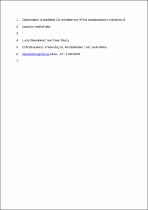 ResearchSpace
ResearchSpace
Optimisation of stabilised carboxylesterase NP for enantioselective hydrolysis of naproxen methyl ester
JavaScript is disabled for your browser. Some features of this site may not work without it.
- ResearchSpace
- →
- Research Publications/Outputs
- →
- Journal Articles
- →
- View Item
| dc.contributor.author |
Steenkamp, Lucia H

|
|
| dc.contributor.author |
Brady, D

|
|
| dc.date.accessioned | 2009-05-05T14:19:05Z | |
| dc.date.available | 2009-05-05T14:19:05Z | |
| dc.date.issued | 2008-12 | |
| dc.identifier.citation | Steenkamp, L.H. and Brady, D. 2008. Optimisation of stabilised carboxylesterase NP for enantioselective hydrolysis of naproxen methyl ester. Process Biochemistry (2008), pp 38 | en |
| dc.identifier.uri | http://hdl.handle.net/10204/3349 | |
| dc.description | This is the author's version of the work. It is posted here by permission of Elsevier for your personal use. Not for redistribution | en |
| dc.description.abstract | Although the enantioselective kinetic resolution of ester racemates of the non-steroidal antiinflammatory drug naproxen ([2-(6-methoxy-2-naphthyl) propionic acid]) is a common demonstration for biocatalysis, the enantiomeric excess of the reactions is usually insufficient to warrant commercialisation. However, optimised reactions using heterologously expressed Carboxylesterase NP provided highly enantioselective hydrolysis of racemic naproxen methyl ester. Up to 46.9% conversion was achieved in 5 h in the presence of 10 units enzyme/g ester with a product ee of 99% and an E of approximately 500. The final optimised reaction conditions were 150 g/l of substrate slurry in 0.01 M sodium phosphate buffer pH 8.75 (maintained with 2.5 M NaOH) at 45 8C and in the presence of 1% surfactant (Tween 80). Stabilisation of the enzyme with >2000 ppm formaldehyde prior to use resulted in an optimal volumetric productivity of 22.2 g/l/h substrate at an enzyme loading of 18 units enzyme/g ester. Reaction kinetics revealed that the product S-naproxen formed causes product inhibition, but not enzyme toxicity, and resulted in the decrease in reaction rate with conversion. The R-NME (naproxen methyl ester) (unwanted enantiomer) did not have a significant influence on the reaction rate. DBU (diazobicycloundecene), used for the racemisation of the unwanted enantiomer, was recycled with the substrate but did not influence the conversion rate | en |
| dc.language.iso | en | en |
| dc.publisher | Elsevier | en |
| dc.subject | Naproxen methyl ester | en |
| dc.subject | NME | en |
| dc.subject | S-naproxen | en |
| dc.subject | Carboxylesterase NP | en |
| dc.subject | Enantiomeric excess | en |
| dc.subject | Enzymes | en |
| dc.subject | Conversion | en |
| dc.subject | Enantioselective hydrolysis | en |
| dc.title | Optimisation of stabilised carboxylesterase NP for enantioselective hydrolysis of naproxen methyl ester | en |
| dc.type | Article | en |
| dc.identifier.apacitation | Steenkamp, L. H., & Brady, D. (2008). Optimisation of stabilised carboxylesterase NP for enantioselective hydrolysis of naproxen methyl ester. http://hdl.handle.net/10204/3349 | en_ZA |
| dc.identifier.chicagocitation | Steenkamp, Lucia H, and D Brady "Optimisation of stabilised carboxylesterase NP for enantioselective hydrolysis of naproxen methyl ester." (2008) http://hdl.handle.net/10204/3349 | en_ZA |
| dc.identifier.vancouvercitation | Steenkamp LH, Brady D. Optimisation of stabilised carboxylesterase NP for enantioselective hydrolysis of naproxen methyl ester. 2008; http://hdl.handle.net/10204/3349. | en_ZA |
| dc.identifier.ris | TY - Article AU - Steenkamp, Lucia H AU - Brady, D AB - Although the enantioselective kinetic resolution of ester racemates of the non-steroidal antiinflammatory drug naproxen ([2-(6-methoxy-2-naphthyl) propionic acid]) is a common demonstration for biocatalysis, the enantiomeric excess of the reactions is usually insufficient to warrant commercialisation. However, optimised reactions using heterologously expressed Carboxylesterase NP provided highly enantioselective hydrolysis of racemic naproxen methyl ester. Up to 46.9% conversion was achieved in 5 h in the presence of 10 units enzyme/g ester with a product ee of 99% and an E of approximately 500. The final optimised reaction conditions were 150 g/l of substrate slurry in 0.01 M sodium phosphate buffer pH 8.75 (maintained with 2.5 M NaOH) at 45 8C and in the presence of 1% surfactant (Tween 80). Stabilisation of the enzyme with >2000 ppm formaldehyde prior to use resulted in an optimal volumetric productivity of 22.2 g/l/h substrate at an enzyme loading of 18 units enzyme/g ester. Reaction kinetics revealed that the product S-naproxen formed causes product inhibition, but not enzyme toxicity, and resulted in the decrease in reaction rate with conversion. The R-NME (naproxen methyl ester) (unwanted enantiomer) did not have a significant influence on the reaction rate. DBU (diazobicycloundecene), used for the racemisation of the unwanted enantiomer, was recycled with the substrate but did not influence the conversion rate DA - 2008-12 DB - ResearchSpace DP - CSIR KW - Naproxen methyl ester KW - NME KW - S-naproxen KW - Carboxylesterase NP KW - Enantiomeric excess KW - Enzymes KW - Conversion KW - Enantioselective hydrolysis LK - https://researchspace.csir.co.za PY - 2008 T1 - Optimisation of stabilised carboxylesterase NP for enantioselective hydrolysis of naproxen methyl ester TI - Optimisation of stabilised carboxylesterase NP for enantioselective hydrolysis of naproxen methyl ester UR - http://hdl.handle.net/10204/3349 ER - | en_ZA |





